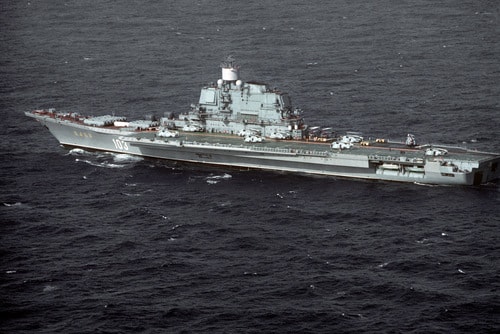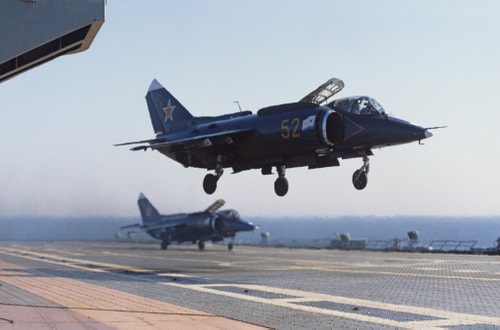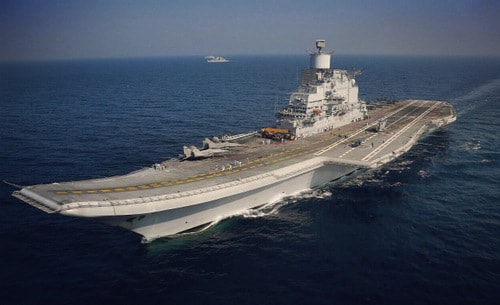The Soviet Union's unsuccessful hybrid aircraft carrier class
The Kiev-class battleships are a hybrid design between a cruiser and an aircraft carrier, but cannot perform any specialized missions.
 |
Baku, the most modern aircraft carrier in the Kiev class. Photo: Wikipedia. |
At the end of the Cold War, the Soviet Union built a series of Kiev-class aircraft carriers in an effort to build the first fixed-wing fighter-powered naval air force, aiming to transition from a land power to a sea power and challenge the US Navy's ocean dominance, according to National Interest.
Military expert Kyle Mizokami commented that the birth of the Kiev-class warship raised the level of the Soviet navy, helping the country project its power to the world, especially when they did not have a long-range strike force to deal with the US sea blockade during the Cuban missile crisis.
Despite the huge investment in submarines, Sergei Gorshkov, the Soviet fleet admiral, still wanted a balanced force of submarines and surface ships, capable of deploying to distant seas. With the US about to deploy Trident C-3 submarine-launched ballistic missiles, the Soviet navy needed the ability to operate far from the Eurasian continent to counter, leading to direct competition with the US aircraft carrier strike force.
In addition, many countries around the world became allies of the Soviet Union, giving them access to more seaports. From there, Moscow also wanted to maintain a network of foreign allies, which required the presence of offshore naval forces. The four aircraft carriers of Project 1143 "Krechyet" (Kiev class) were part of the effort to serve these two goals.
The Soviet Union launched the aircraft carrier Kiev in 1975, before adding Minsk in 1978, Novorossiysk in 1982, and Baku in 1987. All four ships were built at the Nikolayev South Shipyard in Ukraine, the only Soviet facility capable of building large surface ships.
Like the Moskva-class ships before them, the Kiev-class ships were a hybrid of several ship types, with the forward half resembling a guided-missile cruiser and the rear half resembling an aircraft carrier design. The Soviets designated the Kiev-class as a "heavy fighter cruiser." The ships displaced 45,000 tons and were 271 meters long, 85% the length of the American Nimitz-class supercarriers.
The front half of the Kiev is equipped with powerful firepower with 8 P-500 Bazalt anti-ship missiles, each carrying a 907 kg high-explosive warhead or a nuclear warhead with a destructive power equivalent to 23 US bombs dropped on Hiroshima. The P-500 missile has a range of 550 km, receiving target data from Tu-95 reconnaissance aircraft or helicopters of the air group right on the ship. Nuclear warheads are a very effective option to deal with US aircraft carrier battle groups, just one missile penetrating the air defense net is enough to destroy the entire Washington aircraft carrier battle group.
 |
Yak-38P fighter landing on Kiev-class aircraft carrier. Photo: Wikipedia. |
Designed to directly confront US aircraft carriers, the Kiev class is equipped with a dense air defense network. The first three ships are integrated with two M-11 Shtorm air defense missile launchers with 72 missiles in reserve, while the Baku carries 192 air defense missiles of the 3K95 Kinzhal system. Each ship also carries 40 missiles of the 9K33 Osa complex.
The ship's close-in defense system includes eight 30mm AK-630 gun mounts. In addition, the Kiev class is also equipped with two 76mm guns at the bow and stern, along with two RBU-6000 anti-submarine rocket launchers and 10 torpedoes.
The real innovation in the Kiev class, however, is the ability to deploy naval aviation. The ship has a flight deck that is offset 6 degrees from the longitudinal axis of the hull, parallel to the bridge and extending to the stern. The flight deck takes up two-thirds of the overall length of the ship, while the remainder retains the traditional missile cruiser design.
The Kiev class is designed to carry 20 Yak-38 fighters with vertical take-off and landing capability. When operating at sea, each ship usually carries 13 Yak-38 fighters and 12 Ka-25 helicopters. The Ka-25 squadron can perform target designation tasks for P-500 Bazalt missiles, anti-submarine warfare and search and rescue.
After the collapse of the Soviet Union, these ships were taken over by Russia, but maintenance was not possible because the South Nikolayev shipyard and spare parts were located in Ukraine, causing all four Kiev-class ships to be decommissioned. China bought the Kiev and Minsk. The Kiev was towed to Tianjin and converted into a luxury floating hotel, while the Minsk was put on display. The Novorossiysk was dismantled for scrap metal in the port of Pohang, South Korea, in the 1990s.
Baku, the last of the Kiev class, was also the most modern and in good condition and was renamed Admiral Gorshkov before being sold to India for conversion into a full-fledged aircraft carrier. When handed over to the Indian Navy, she was renamed INS Vikramaditya and served as flagship.
 |
The Baku was converted into the aircraft carrier INS Vikramaditya. Photo: Wikipedia. |
The Kiev-class aircraft carrier was an ambitious project of the Soviet Union to create a warship capable of confronting US aircraft carriers and hunting down enemy strategic submarines. However, due to its "half-baked" design, not specialized for a specific mission, the actual combat capability of the Kiev-class is very limited, Mizokami expert commented.
According to VNE
| RELATED NEWS |
|---|

